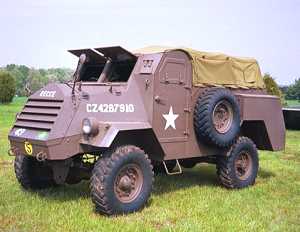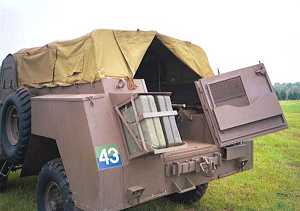 |
The
General Motors of Canada C15TA Armoured Truck was a four-wheel drive personnel
transport built upon the standard 15cwt truck chassis. Powered by the American
270ci six-cylinder OHV engine, it performed exceptionally well in its assigned
function, eventually replacing the American halftracks and White Scout
Cars in Canadian service. According to Gregg, a total of 3,961 were produced,
with most being sent overseas. |
|
 |
The
first thing which strikes you about the C15TA is its comparative height
and size. With its unique bull snout and slab sides, the C15TA, at almost
8 feet tall, projects a sense of raw power and purpose. This superb example
of a C15TA in No.2 Brown was seen at a private museum in the United States.
It is complete in just about every respect, inside and out. |
|
 |
Another
frontal view. The C15TA was produced in 1944-45. Along with virtually all
other Canadian vehicles in Northwest Europe, the survivors were left in
the Netherlands at the conclusion of hostilities, and were dispensed out
to the newly-constituted armed forces of liberated countries, including
Denmark and the Netherlands itself. Many examples served honourably for
decades after the war in a variety of roles. Few remain. Needless to say,
if you hear of any, please contact us forthwith! |
|
 |
The
famous snout, shared only with the Otter armoured car. The C15TA was built
upon a basic 15cwt chassis, but equipped with 10.50 x 16 tyres for additional
ground clearance and a better footprint. By all accounts, tractability
was superb, and the power-to-weight ratio with the 270 impressive. |
|
 |
Left
rear view shows details of jerrycan stowage, pintle hook and tools. Note
that the British-style POL containers have been dispensed with in favour
of the better and more conventional type. Note also the enormous stowage
bins which double as rear fenders. The two brackets on the bottom outside
of the body itself are protectors for the tail lights which also double
as steps. |
|
 |
The
same view but with the tarp buttoned up and the armoured door open for
easy access. The slot in the door here carries on set of collapsible wire
stowage bins from inside the troop compartment. It can also hold the removeable
footwell plates from inside (see below). |
|
 |
Right
rear view showing the stowage bin and the driver's door latched open. |
|
 |
Right
side profile. The side armour around the troop compartment only extends
to the tarpaulin, presumably to save weight. As will be seen below, very
late in the war an ambulance version was produced with armour extending
all the way up, and one can only surmise that had the war continued, similar
troop-carrying versions may have been introduced. |
|
 |
The
driver's station, looking forward. Instrumentation and controls are basic,
late-war CMP. The engine cover is unique, however. The driver and co-driver
were protected by a thin armoured roof. This particular example is fitted
with a stretcher mounted on detachable brackets which were issued with
every vehicle. |
|
 |
Looking
forward to the co-driver's station detail with the armoured windshield
cover closed. The latch mechanism is crude but effective. Visibility in
this mode is minimal, but must have been a great comfort once the bullets
started flying. Note the 'pistol' ports, a holdover from earlier days.
I suspect they were seldom used except as fresh air vents. |
|
 |
This
left side view shows detail of the co-driver's station. The bin in the
door holds glass windscreens which can be fitted in rear areas. The upper
section in both side doors opens down and out for visibility in non-combat
zones. Note that the co-driver's door cannot be latched open as can the
other one, due to the spare tyre. |
|
 |
A
view inside to the right shows the stretcher in its mount as well as details
of the robust roof bows. Noticeably absent are the six troop seats - two
in the rear, and two pairs back-to-back facing outwards up forward. There
is no evidence in this vehicle that they were ever installed, leading me
to wonder if this was a late-war convention. Anyone? |
|
 |
Left
side of the troop compartment facing rear from the co-driver's station.
The collapsible wire bin is the same as that stowed in the rear door. They
would be used for personal kit for both crew and troops. Note the rifle
clips in the forefront. Also visible rear centre is the removeable floor
plate which would open up to reveal footwells. In the original design,
the two folding rear troop seats were bolted to the checkerplate perpendicular
to the visible diagonal edges of the footwell. |
|
 |
The
left forward side of the troop compartment showing footwell and rifle clips.
Two side-by-side troop seats would have faced outward here. Total seated
troop accomodation was six, but by removing the seats, many more could
be crammed in, and I suspect that this may have been a normal procedure.
In this vehicle, there are no mounting holes for said seats at all. I'd
love to talk to someone who may have served in these indispensible vehicles. |
|
 |
This
archival photo shows an unidentified troop of GM C15TA armoured trucks
loading an element of Royal Hamilton Light Infantry (RHLI) in late October,
1944. By this time the RHLI and the rest of the 2nd Canadian Infantry Division
were deep into a wet, cold and furious battle for control of South Beveland
on the east side of the Scheldt Estuary. |
|
 |
A
more-or-less complete, preserved C15TA with original canvas currently on
display at the Canada Museum at Aadegem, Belgium.
The C15TA
was the most successful armoured vehicle to come out of GM Oshawa. I wonder
why it was never given a name... (photo
by Chris Werb) |
|
 |
This
is a restored example of the rare late-war ambulance version introduced
in 1945. Note the higher side plates. This example was restored by a collector
in Great Britain, but now lives in the Canadian War Museum in Ottawa, Ontario.
It's not difficult to imagine the value of such a vehicle had it been available
throughout the campaign in 1944. (photo
by Bruce Parker) |
|
|
Other C15TA
pages on the web :
|
Canadian
Tracks |
|
C15TA
AKA Mosegris |
|
 11 Feb 00
11 Feb 00 |
Back
to CMP Armour |
|
| Copyright ©
Geoff
Winnington-Ball , 1999 - All Rights Reserved |